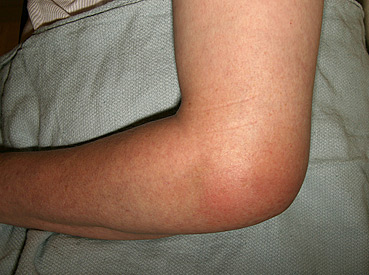Elbow Fractures
What are Elbow Fractures?
Fractures of the bones of the elbow—the radius, ulna and the humerus—include a broad range of combinations and severity. Falls while bicycling, skiing, snowboarding, BMX, skateboarding (full pipes more than street courses) and in-line skating put the elbow at risk when the outstretched arm is used to protect the athlete’s face or spine. Contact sports are culprits too. Fractures may be open or closed, displaced or nondisplaced. An injury that causes a broken bone may also damage muscles, ligamentous tissue, and nerves and arteries that surround the bones, necessitating prompt medical supervision.
Types of Elbow Fractures
Elbow fractures may be identified as being either open or closed. In closed fractures, the broken bone will remain beneath the skin. With open fractures, a fragment of the bone will break through the surface of the skin.
In displaced fractures, bones are separated into two or more misaligned pieces. These pieces may or may not maintain contact with each other. A nondisplaced fracture will mean that the pieces of broken bone have separated little and the fragments remain almost in place.
Some examples include:
- Olecranon fracture: fracture of the pointed end of the ulna.
- Radial head fracture: fracture of the radius bone in the forearm that meets the humerus.
- Distal humerus fracture: fracture of the humerus meeting the radius and ulna.
Characteristics and Clinical Presentation of Elbow Fractures
The elbow is a hinge joint that allows you to move your forearm. A fracture may occur in one or more of the bones, including the humerus, the radius, and ulna, resulting in pain and impaired movement in the region. Fractures in these areas tend to be painful upon trauma and easily distinguishable due to deformity and swelling.
Some of the most commonly reported symptoms for elbow fractures include:
- Severe pain, sometimes less
- Limited motion
- Swelling
- Tenderness
- Cracking (crepitus) when the arm is bent or straightened
- Inability to extend elbow
- Difficulty rotating forearm
Getting a Diagnosis for Elbow Fractures
X-rays provide images of bony structures, which are useful in diagnosing elbow fractures. The upper arm, forearm, wrist, and hand may all benefit from this imaging.
Depending on the patient’s symptoms, the surgeon may also order an MRI to visualize ligamentous injuries or a CT scan for better bony analysis.
Treatment Options for Elbow Fractures
Treatments range from sling immobilization to complex reconstructive surgery of the bones and ligaments. Subsequent physical therapy is the norm. Immediate treatment options include applying ice to the area to reduce pain and swelling and non-steroidal anti-inflammatories to relieve pain. A splint may also be beneficial in providing immediate pain relief.
Conservative Treatments
If the fracture is not displaced, the fracture may be treated with a splint or sling to immobilize the elbow to promote healing. Periodic X-rays may be ordered during this process to try to ensure the bone has not shifted.
Splints are generally worn for a short time when gentle motion is reintroduced. If the fracture shifts during this time, surgical intervention may be required. Non-steroidal anti-inflammatories may also be prescribed during this time.
Surgical Treatments
Surgical intervention is usually required for olecranon and other fractures in cases of open or displaced fractures. Surgery typically involves realigning the bones and reassembling broken pieces into the best possible position.
Open fractures are scheduled for surgery quickly to reduce infection risk. Patients with this type of fracture will also be administered antibiotics.
Surgical reduction of elbow fractures is standard in fractures that do not respond to conservative treatment, and when conservative management is known to yield inferior outcomes.
Preventing an Elbow Fracture
It is difficult to prevent an elbow fracture as it is an acute injury that occurs due to a forceful blow or strike. The use of proper, well-fitted safety gear is vital to protecting the body during athletic activities.
Athletes may protect themselves from possible elbow fractures with the following:
- Learning proper sports techniques and body mechanics.
- Maintaining fitness during the off-season.
- Warming up before athletic activities can prevent injury and learning falling techniques
- Drink water, because dehydration can affect fitness levels and endurance.
- Wear well-fitted safety gear and appropriate clothing during athletic activity.
Prognosis for Elbow Fractures
Many patients will experience moderate pain following their surgery, which will benefit from icing, elevation, prescription, and non-prescription pain medications. Regardless of whether or not the required treatment is surgical, the best possible recovery from elbow fractures requires supervised physical therapy.
If You Believe You Have an Elbow Fracture, Contact HandSport Surgery Institute.
Please contact us as soon as possible to schedule an appointment with our talented team. People who have been hurt should be evaluated to try and prevent further injury and mobility issues.
If you have been injured, it’s important to be evaluated by a highly skilled professional. Call Drs. Mark and Jason Pruzansky at 212-249-8700 to schedule an appointment and obtain an accurate diagnosis.



